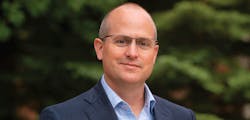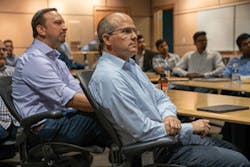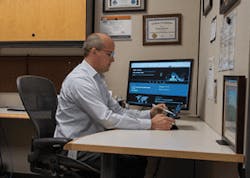Executive Insights Q&A With CenturyLink’s CTO, Andrew Dugan
Learn what Andrew Dugan, CenturyLink’s CTO, says about network automation, fixed wireless, cybersecurity and other investment priorities.
Topic: PRIORITIES
ISE: What are your top network-related priorities for the rest of 2019?
Dugan: As a technology leader, we have many network priorities in place to help meet the growing digital demands of businesses and consumers. Those priorities include the delivery of new services to support the changing needs of our customers, refreshing network technologies to be efficient and easier to operate, investing in network expansion, and creating a more efficient business. One common theme across all these areas is automation. As we develop new services, we’re developing them in a way that enables automation for our customers and employees. As we select and deploy new technologies for efficiency, we’re focused on creating a better and more automated experience.
Topic: TRANSFORMATION AND INTEGRATION
ISE: During the Q1 2019 earnings call, Jeff Storey, President and CEO, shared, "We made solid progress this quarter with our transformation initiatives, which has the primary benefit of improving experience for our customers and employees, along with reducing costs in the business." Talk about the biggest challenges and opportunities for your team in these areas.
Dugan: We’re very focused on enabling our customers’ digital transformation and creating a positive experience for employees and customers through automation. The breadth of our global footprint created from many acquisitions over the years provides us with a tremendous opportunity to meet the needs of our global business customers. However, the biggest challenge we have in this journey is leveraging that expanded footprint across multiple systems and databases. It’s not an easy task to automate but we have a significant part of our network and systems development organization focused on enabling this automation through a combination of consolidation and federation. We’re making good progress.
Topic: LIFECYCLE SERVICE ORCHESTRATION
ISE: Talk about CenturyLink’s work with Lifecycle Service Orchestration (LSO) and APIs. Why is it critical to launch two-way, intercarrier network orchestration for services across networks? What will that lead to in the future? What are the biggest challenges related to it?
As we look to deliver automation for our customers, it’s important to enable that automation not just within our network but also between carrier networks. Although we’re investing heavily in our fiber network, a single carrier’s network doesn’t reach every building where they have customers, so carriers need to work together to expand their reach. Enabling the LSO APIs across carriers will allow CenturyLink to order services from other carriers in a more automated way, and allow them, as well as larger customers, to order services from CenturyLink.
Topic: SON’s FUTURE
ISE: Global investments in SON technology are expected to grow at a CAGR of approximately 11% between 2019 and 2022. This will be driven by the increasing complexity of today’s multi-RAN mobile networks — including network densification and spectrum heterogeneity, as well as 5G NR infrastructure rollouts, By the end of 2022, SNS Telecom & IT estimates that SON will account for a market worth $5.5 Billion. What is CenturyLink’s roadmap in this area?
Dugan: We’re currently working with fixed wireless technology to support our network infrastructure investments as a part of the FCC’s Connect America Fund program but our interest in wireless networks doesn’t stop there. We’ve been using wireless as a part of our network in Latin America for many years as an access technology for customers in that part of the world. This includes using our own licensed spectrum, millimeter wave and satellite.
InvisiLight® Solution for Deploying Fiber
April 2, 2022Go to Market Faster. Speed up Network Deployment
April 2, 2022Episode 10: Fiber Optic Closure Specs Explained…
April 1, 2022Food for Thought from Our 2022 ICT Visionaries
April 1, 2022We also have several trials ongoing for experimentation with millimeter wave technologies in North America to serve both the consumer and business markets. For example, we’re using point-to-multi-point wireless to gain access to campus-style apartment buildings. We’re also experimenting with consumer services that use a self-organizing mesh to deliver high-speed services to dense residential areas. We expect the industry investment going into 5G networks and technologies will help deliver a number of wireless use cases that we can leverage to better serve our customers.
Topic: FIBER
ISE: What are CenturyLink’s plans to capitalize on the need for fiber backhaul for 5G preparedness?
Topic: NETWORK SECURITY
ISE: Telecom providers are often considered keepers of the network. What is CenturyLink doing in network security compared to others?
Dugan: CenturyLink has a full portfolio of security services from network-based firewalls to professional services for developing customer specific solutions to protect their LAN and WAN environments. One area where we are unique is our expanded visibility into threats on the Internet that others can’t see as easily. We have one of the largest Internet backbones in the world and, as a result, we get to see more traffic than others.
Within my organization there is a research and development team called Black Lotus Labs. They’re focused on using artificial intelligence (AI) and machine learning (ML) tools to analyze the traffic traversing our networks. With our network traffic data combined with other sources of threat data, we can understand malicious traffic from threats such as botnets. With the AI and ML tools we can analyze the evolution of those threats and see how they’re changing. We use this intelligence to offer services to our customers and protect our own infrastructure.
Topic: RURAL CHALLENGES AND SOLUTIONS
ISE: What is your greatest pain point delivering higher speeds to underserved and rural communities? What are some solutions?
Topic: HANDS-ON EXPERIENCE
ISE: Your passion for innovation has resulted in more than 20 networking patents over your 30 years in this industry. What does that mean for your team members? How does that passion translate into empathizing with their day-to-day challenges as they work to transform your network?
Dugan: Patents represent novel ideas for solving our business challenges. Part of my role is to step back and help our teams think about the bigger picture and how they can approach problems differently to get the desired outcome. I’m naturally a curious person and this process allows me to satisfy that curiosity by asking questions that get us to think about things in new and innovative ways.
Topic: AGILITY
ISE: A business needs to run 2 models simultaneously: 1 optimized for today, and 1 optimized for tomorrow. How do you do that well without neglecting one or the other?
Dugan: I use 2 different approaches. First, I focus on the long term and work to define where we want to be in the long run. While we have tactical challenges every day we need to solve for, I try not to let those challenges lead us down paths away from the longer-term goal. Each step along that journey may not be on a straight path but if we’re moving a little closer to the goal with each step, I consider that success. Second, I’ve always had a team that’s been focused on nothing but defining our network architecture strategy. Those strategic teams deliver roadmaps and high-level plans to other teams that make the strategy real and deal with the tactical issues associated with that process.
Topic: CHANGE
ISE: How do you embrace change and encourage risk-taking across your teams?
Dugan: I believe in empowerment of the team. By making sure that responsibility, authority and desired outcomes are clear, teams can feel empowered to make decisions that help them accomplish their goals. Those decisions will include some risk-taking so it’s important to expect that we’ll have some failures along the way, but that same empowerment will also enable people to quickly make adjustment decisions to correct for those failures. It’s also important to recognize that along with the responsibility and authority comes accountability. Risk-taking is good, failure is ok, but it’s also important to hold people accountable for achieving the right outcome over time.
Topic: SUBTLETIES
ISE: Share your thoughts about this quote:
"A boss has the title; a leader has the people." (Source: Simon Sinek)
Dugan: I’m not someone focused on titles; I believe in creating an organization that doesn’t put emphasis on levels and hierarchy. People will follow leaders across the organization because those leaders are focused on creating a vision and plan they can identify with and can get excited about. A title doesn’t make you a leader, connecting with the people at every level throughout the organization that you lead makes you a leader.
Topic: WHAT MATTERS
ISE: What are 3 words that describe you?
Dugan:
Strategic.
Collaborative.
Curious.
Topic: BALANCE
ISE: What do you do to help create work/life balance in your life?
Dugan: I have family and friends who are important to me, and it’s a top priority for me to make time for them. I set aside time for work as well as time for the rest of my life. I’m a morning person so I get up early and try to get to work between 6:00 and 6:30 a.m. That works well for work/life balance because the people in my life outside of work aren’t usually up at that time. While I do get to work early, you won’t often find me in the office after 5:00 p.m.
Like this Article?
Subscribe to ISE magazine and start receiving your FREE monthly copy today!
Andrew Dugan is Chief Technology Officer for CenturyLink. In this role, he is responsible for the development, integration and deployment of CenturyLink’s global network supporting Consumer, Wholesale, Government and Enterprise markets.
Andrew is a veteran technology executive with more than 30 years of experience in building telecommunications networks, switching platforms and services platforms. Prior to his CTO role, he served as CenturyLink senior vice president of technology planning, network architecture and security. He joined Level 3 in 1998 where he played an integral part in building its global network. He held various roles at Level 3 and was named its CTO in 2016.
Before joining Level 3, Dugan designed and built transport network support systems, enhanced voice services
platforms and next generation voice switching networks for MCI WorldCom. He also worked for AT&T Bell Laboratories.
Dugan is an innovator with more than 20 networking patents. He holds a bachelor’s degree in computer science and electrical engineering from the University of Colorado and a master’s degree in computer engineering from the University of Michigan.
About the Author
Sharon Vollman
Content Ambassador for ISE EXPO
Sharon Vollman is the Content Ambassador for ISE EXPO. She is passionate about collaborating with thought leaders, SMEs and hard-working doers who design, plan and deploy ultra-reliable broadband networks. Vollman is committed to creating a variety of educational offerings for ISE EXPO attendees that inspire them to connect every U.S. citizen with the broadband networks we all want for our children and grandchildren.
Vollman has created educational partnerships with Broadband Service Providers including AT&T, Verizon, Lumen, Frontier Communications and others. She has covered the telecom industry since 1996.








